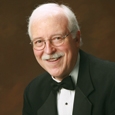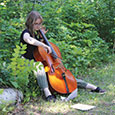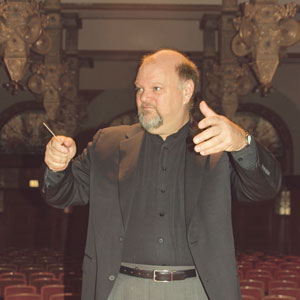 Stephen Squires believes conductors should be ready for any opportunity and his varied activities reflect that philosophy. He is the principal conductor and professor of conducting at Chicago College of Performing Arts, Roosevelt University. He also conducts the Elgin Symphony Orchestra, the Illinois Brass Band, and the Mendelssohn Chamber Orchestra. These varying posts require great flexibility in conducting style. He notes that “Some musicians require more jostling and others will stay with you the whole time. When I am on the podium I try to talk only about those concepts I cannot convey with my hands. If I can get a better legato using my hands, I don’t have to stop to discuss it.”
Stephen Squires believes conductors should be ready for any opportunity and his varied activities reflect that philosophy. He is the principal conductor and professor of conducting at Chicago College of Performing Arts, Roosevelt University. He also conducts the Elgin Symphony Orchestra, the Illinois Brass Band, and the Mendelssohn Chamber Orchestra. These varying posts require great flexibility in conducting style. He notes that “Some musicians require more jostling and others will stay with you the whole time. When I am on the podium I try to talk only about those concepts I cannot convey with my hands. If I can get a better legato using my hands, I don’t have to stop to discuss it.”
What are your objectives when you step on the podium to work with a new ensemble?
I try to teach musicianship and musical knowledge to ensembles, rather than attempting to fix every problem. I have had some remarkable conducting experiences, but most of the time I am working with students who are still learning. I want to give them the skills to solve problems without help from me. A room full of people working on musical solutions is so much better than just one.
Many students have terrific technique but still lack skill at making decisions and want to be told what to do. I encourage students to take a more active role by asking. If I notice a section of a group is playing notes of different lengths, I might say “I don’t think we all agree.” I try to get students to figure out an appropriate articulation on their own. The principals for each section reach an agreement and share it with the rest of the section. If I don’t have to stop frequently to make minor corrections, students can focus more on the emotions and other issues related to our interpretation of the music.
Music employs both the logical and emotional side of the brain, and it is sometimes too easy to focus excessively on purely technical problems. Musicians and audiences enjoy music because of how it makes them feel. I would rather hear a performance with passion and a few technical imperfections.
What technical issues are particularly important to address before working on the emotions of a piece?
As a young conductor I remember the struggle of trying to produce slow music that did not rush and quick music that did not drag. In these situations is it tempting to conduct very rhythmically in an effort to get everybody to hold the tempo. I found over the years that the secret to getting an ensemble to play together is to share the responsibility for keeping the pulse with the players in the group.
When I guest conduct high school groups and notice a piece is rushing, most of the players know it even if they are not taking steps to fix the problem. The leaders of the group have to anchor the pulse and other the players will follow suit. Sometimes in a rehearsal I will stop conducting to see if the ensemble can maintain the pulse without my help. They always can and this frees me to focus on shaping phrases and musical lines.
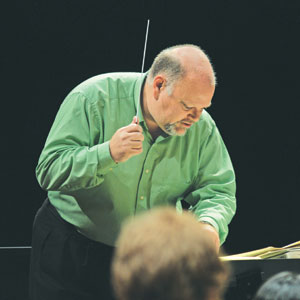 How do you help young conductors improve their skills on tuning?
How do you help young conductors improve their skills on tuning?
A conductor has to understand that harmonic or just tuning and equal temperament are different. A tuning device is wonderful for understand the tendencies of an instrument in all ranges and notes but cannot correct an ensemble’s tuning problems. To tune a major chord properly, the 5th has to be slightly sharp and the 3rd has to be significantly flat compared to equal temperament. A minor chord requires a high 3rd, while the 5th remains the same. Some directors are reluctant to discuss this concept with high school students but I have found that most players are able to make the minor adjustments need to play the chord in tune.
I recommend tuning perfect intervals every day using different groups of players. In a band there is nothing special about A or B flat as a tuning note. In an orchestra the A is significant because all of the string instruments share open string As and perfect intervals around them. With wind instruments I might select three different players to tune 5ths, 4ths, and octaves. I could start this exercise with three saxophones and evenutally use a saxophone, tuba, and flute. If we are playing a piece in C major, we might try tuning to C, F, and G because these notes are the harmonic pillars of the key and require the least amount of adjustment away from equal temperament to be in tune. The next day the whole sequence can be repeated on E flat, A flat, and B flat.
I tell students to listen for a beatless sound that is pleasing to the ear. In some ways tuning two people on the same note is the most difficult and perhaps least useful exercise for young players. However, it is also the most obvious when two unison players are out of tune because the pulsing in the sound is stronger. As soon as the light goes on and they appreciate the purity and richness of a beatless sound, players won’t accept it when it isn’t good.
I teach an advanced rhythm and intonation class. One of the best prectice techniques we use is tuning with slide whistles. The whistles guarantee than everyone in the class is at the same timbre. If they can get all of the pitch relationships in their ears with the slide whistle it is much easier to do it on their primary instrument.
What techniques do you use to help players become aware of balance and blend?
I use concepts of color to search for a unified sound. Two players on the same instrument will produce different tone colors. I might ask the person with the darkest tone to make it brighter or ask the brightest player to darken his sound. The key is to encourage greater flexibility in tone, so that players are always making slight modifications to their sound to match other players. These changes are easier to make in a section but often more difficult to hear with dissimilar instruments.
In balancing the ensemble these slight adjustments in color can make a big difference in the sound. For an accompanying line, a darker tone may work best while a brighter sound will allow the lead to project better. If the flutes have the melody in the lower register, that dark sound will have a hard time penetrating unless the rest of the ensemble plays with as a very dark tone. Some-times the adjustment is as simple as having the brass play into their stands. Players become much more skilled as they think about their role in the music and how their choice of tone and dynamic can contribute to a good blend and balance.
Most of the time musicians are practicing by themselves and searching for the ideal sound. When individuals become part of an ensemble, the sound of the group becomes more important than individual goals. The goal is to listen to other people even more than yourself. In a chord, if your tone is what you hear predominantly, it is much harder to find the right intonation that makes the chord sing.
Directors will frequently comment that if you cannot hear a solo line when you are accompanying, you are too loud. Excellent ensemble playing is only possible through a willingness to listen. This can be complicated by playing in a large section with the temptation to listen only to others playing the same line. Try to always listen to the contrasting parts.
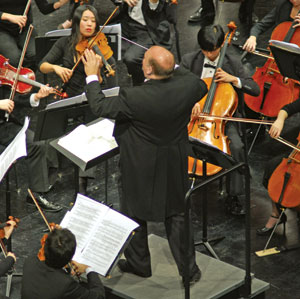 How has your conducting style evolved to help players listen more closely?
How has your conducting style evolved to help players listen more closely?
It is not rewarding to conduct in a way that forces players to watch all the time. I’ve played for conductors who would would inadvertantly make the music fall apart due to poor conducting and blame it on the payers for failing to watch. That approach turns players into trained seals, always watching the baton, although that is certainly one way to get musicians to play together.
I prefer to conduct so that I can affect the performance as they see me through peripheral vision. My gestures are large enough to be visible even without direct eye contact. I try to conduct in a simple way so that more dramatic gestures get noticed, and I believe that ensemble listening and interaction is equally important. The goal is to produce a group that listens so well that if I stopped conducting, the music could continue. I take the lead in shaping the sound, but everybody is responsible for it. I do not want musicians to feel like puppets controlled by the conductor.
What advice do you have for younger conductors coming up in the profession?
Conductors often have the same problem as instrumentalists. They can focus so much on developing technique that the expressive part of the music is wanting. I ask conductors to explore how the music makes them feel. If they can tap into their emotions, that is a powerful tool.
I will occasionally ask students to express how the music should sound using no musical terms. They might say the music should feel confident, playful, or frightening. The adjectives help the director think about the emotional content of the music and convey that to the players and audience.
Singing is another powerful tool that young conductors should employ more frequently. I sing frequently in rehearsal because it is sometimes easier to sing a line than to describe it in words. Often singing can be beneficial in surprising ways. When conducting a march, the focus might be on the rhythmic elements of the music, but there is also a singing component to the shape of the phrases. It is important to look at music from a variety of angles.
Conductors can only bring the breadth of their experience to the music, so young conductors should take every opportunity the can get. Take a church choir, work with amateurs, or conduct a local musical. Anything you can get involved with helps you grow as a musician. One of my teachers told me that if you want to be a musician, you have to learn to say yes. Even now, I only turn down a chance to conduct or perform if it would cause me to be double booked.
The most common technical problem for young conductors is delivering a clear beat that players can follow. All conductors take a different ap-proach to giving the beat. Some conductors choose to conduct almost a beat ahead; others like to feel the beat at the top, at the rebound. Most problematic is the beat syle where the baton rushes almost to where the next beat should be and then pauses before giving the beat. the baton then rushes to the next beat, followed by another moment of hesitation. This is frustrating for the players because the baton is not moving in accord with how the pulse feels to them. Directors have to learn how to give the beat with a more fluid motion and to be in sync with the music from the players’ perspective.
Players of all ages can sniff out a conductor who is inauthentic on the podium. When someone is unreasonably complimentary or critical, players can usually tell that this is acting. Still, there is an element of showmanship to conducting. If stepping on the podium makes you nervous, you somehow have to work through the fear and seem more confident than you are. You try to be a stronger version of yourself.

